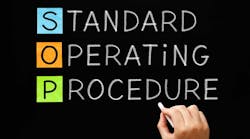It’s tempting to start inputting data immediately after purchasing a computerized maintenance management system (CMMS) or enterprise asset management (EAM) software. Companies are often eager to utilize CMMS systems to begin optimizing spare parts inventory, streamlining proactive maintenance activities and more. Before doing anything, however, it’s critical to develop standard operating procedures (SOPs) for a maintenance software system. The process of creating SOPs for CMMS identifies the “who, what, when, and how” associated with the software.
Why Use SOPs?
SOPs provide consistency and accuracy within maintenance management software, which is a significant financial investment. General goals of successfully implementing CMMS software include:
- Enhance reliability of equipment, whether it’s used for manufacturing or simply aids in the operation of the facility
- Provide management with a means to analyze operations, departments and equipment—which helps in future short-term and long-term planning
- Increase efficiency of operations or production by maximizing machine uptime
These goals can easily be accomplished by taking steps to ensure all data in the CMMS is properly entered and maintained. Doing so helps organizations implement CMMS successfully and also helps maximize its full potential, and thus return on investment (ROI).
SOPs have been relevant for many years, existing in numerous organizations and departments. Standardizing procedures within a CMMS is a necessary step—it affects all present and future users. Instructions on how to populate and use the program are often provided by vendors in the form of manuals or web tutorials. These user guides or tutorials typically define program tables, records and fields in addition to explaining how to operate the software. It’s best to take advantage of all training resources available with a CMMS software purchase, and explore additional training opportunities as needed.
The Importance of Training
Carving out ample time to properly train employees on the SOPs and the CMMS helps ensure the software creates valuable benefits for a company. One such benefit is viable data within the software that can be used to influence future management decisions in the months or years ahead. It’s difficult to rely on and use data entered by an employee lacking adequate software training. After basic training, meet collectively with all team members that are likely to provide or input CMMS data, including those that close out work orders or purchase orders. It’s important to gather feedback from these stakeholders when developing SOPs, especially as it relates to each person’s functional portion of the data input. The resulting SOPs should be formally recorded, published and easily accessible—so there is no question as to who does what, when and how. Specific responsibilities must be outlined for all current and potential users, taking any future changes in staffing into account. This document will prove extremely beneficial in cases of employee turnover, promotions, retirements, etc.
What’s Included in the SOP?
If properly worded, SOPs will increase efficiencies in work responsibilities by clearly stating what the procedure is and how it should be carried out. Any variations from the procedure will, over time, result in waste with associated increased cost. For example, reliability engineers utilize SOPs to perform Root Cause Analysis or Reliability Centered Maintenance. The SOP should clearly state the following minimum requirements for work orders:
- No work is to be performed without an associated work order
- All work order information must be entered into the CMMS program
- All equipment/facility downtime must be recorded on work orders
- All parts used on equipment/facility repair must be recorded on the work order
- All labor time associated with work performed against equipment/facility must be recorded on the work order
- The type of work performed (PM, CM, EM, etc.) on equipment/facility must be accurate and recorded on work order
- Codes that address the following questions must be entered into the code section of the work order or within the comments field of the work order:
- What was the problem
- What caused the problem
- What was done to correct the problem
- What can prevent this problem from recurring
Additionally, a standard SOP format should be adopted by organizations. If an approved format does not currently exist, research possible options online that could be utilized. Once the SOP is created, it’s important for everyone within the organization to follow it at all times. The SOP should include data naming conventions and be adhered to by anyone entering new assets, parts, employees, etc. This is especially important if multiple locations or sites will be using the CMMS system so that cross-site queries and reporting can be done. One example is the ability to see like parts that exist in all locations.
Policy:
- Work Order Close Out – All work performed in the plant must be performed against a valid CMMS work order. Under no circumstances is work of any nature to be performed without a work order. When closing out work orders, the below data is mandatory in order to effectively conduct Root Cause Analysis:
- Equipment Identifier – Verify correct asset is being charged on the work order
- Work Order type – Is correct work type being applied to the work order
- Labor Hours – Assure that all labor hours are captured
- Parts Usage – Verify that all parts are accounted for with correct quantities applied
- Downtime – Record the correct downtime hours with explanation of various department responsibilities for each portion if applicable
- Codes – Address each of the following questions using codes or comments:
- What was the problem
- What was the cause of the problem
- What was done to correct the problem
- What can prevent this problem from recurring
- Comments – The above code entries can be entered in this field if a code(s) field does not exist in the CMMS program.
Purpose:
- Improve overall system reliability through root-cause analysis
- Decrease overall system downtime by elimination of recurring issues
Better spare parts inventory management by accounting for all parts utilized.
Scope:
- Maintenance Operations
- Production
- Engineering
Responsibilities:
Director of Maintenance
- Overall responsibility for the administration, implementation, operation and upkeep of the CMMS program
- Provide annual report to the Vice-President on the overall status of the CMMS program, including Work Order close out compliance.
Maintenance Supervisor
- Verification of completion of all maintenance work order items
- Review of procedures to insure maintenance is adequately conducted
- Recommend improvements and changes to the system
- Perform quality checks periodically on completed work orders
- Assign work orders to properly trained and qualified mechanic/technicians
- Provide explanation to Director of Maintenance if Work Orders are not completed as scheduled.
Planner/Scheduler
- Provide scheduling of all Work Orders
- Review close out of Work Order required items are complete
- Ensure Work Orders are scheduled for properly trained and qualified maintenance technician crafts.
Mechanic/Technician
- Perform work as stipulated on work order
- Provide required feedback on work order procedure
- Close out work order properly by including the following data:
- Equipment Identifier – Verify correct asset is being charged on the work order
- Work Order type – Is correct work type being applied to the work order
- Labor Hours – Assure that all labor hours are captured
- Parts Usage – Verify that all parts are accounted for with correct quantities applied
- Downtime – Record the correct downtime hours with explanation of various department responsibilities for each portion if applicable
- Codes – Address each of the following questions using codes or comments:
- What was the problem
- What was the cause of the problem
- What was done to correct the problem
- What can prevent this problem from recurring
Definitions: What words are used in this SOP procedure that readers may not understand?
- Procedure: What are the activities, tasks or steps to this SOP procedure?
- Effectiveness Criteria: What is important to measure?
- References: What references support this SOP procedure?
- Revisions: What changes have occurred since publishing this SOP procedure?
To summarize:
- Obtain training for all possible CMMS users.
- Develop SOPs collectively with all users. Define who does what, what is done, when it is done and how it is done.
- Publish SOPs.
- Standardize data entry by documenting requirements and always follow those standards.
- Monitor, monitor and monitor the database at all levels.
Robert Brieck is a professional services consultant for DPSI, a provider of CMMS and EAM software. Robert has more than 40 years of experience as a senior level maintenance administrator at a number of organizations, most recently with the Community College of Allegheny County.





